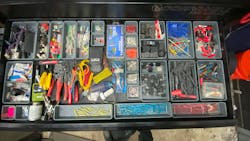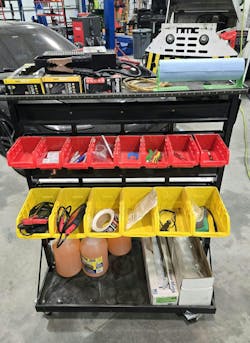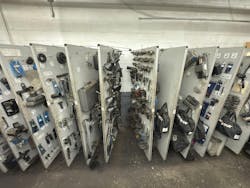Key Highlights
- Keeping technician and shop tools organized is critical to uptime and efficiency
- For technicians, tool grids and a by-drawer organization system can help to avoid losing tools
- For shops, storing and organizing communal tools can be done with a cart method, locker organization system, or with flippable tool boards
In the shop, every minute counts toward productivity, efficiency, and the bottom line. That means all those extra minutes per job a techncian spends searching for the right tool add up. And it might not seem like much at the time, but tool organization has a big effect on productivity.
Oftentimes, this is forgotten in the chaos of trying to get trucks in and out of the bay.
For instance, when Missy Albin, senior lead master technician at Taylor and Lloyd and ambassador technician of International Trucks, said she starts getting into “pile mode,” or simply throwing her tools into her toolbox between jobs so she can move on as quickly as possible, “I happen to lose the most important things,” she said. In particular, 8mm, 10mm, and 13mm sockets have a habit of disappearing, no matter how many backups she started the day with.
“I can never find them when I’m disorganized,” she added.
And that inefficiency can add up quickly, regardless if a technician is searching through their own toolbox or trotting all over the shop looking for communal equipment. To help cut down on this inefficiency and give every tool its place, here are some methods for shop and personal tool organization.
Personal tool organization
To keep those pesky 8mm sockets from walking away, Albin said that she has several smaller systems she uses to keep her tools straight. In particular, she said she relies on tool grids from Cornwell Tools.
“Half of my box is built into these tool grids, and half of it I need to save up and do,” she said. This allows her to fix her sockets in place where she can easily see them, edit her tool layout as necessary, and they’re not very expensive, either.
“They're really great systems, and they cut to size to your box, so they'll literally fit onto any toolbox,” she added. “The tool grids all open, and you can just lay your wrenches on that, and you can write or do any design you want on those.” The only downside, especially for organizing her sockets, is that it can be time consuming to screw each socket onto a grid.
Albin also noted that foam inserts are a good way to organize tools as well, such as Milwaukee's customizable foam inserts and Sonic Tools' foam system. However, she also cautioned that the foam inserts could cause technicians to lose space in their toolbox.
Additionally, Albin organizes her toolbox drawers by category, which each drawer assigned to a family of tools. For instance, air-related tools, such as air guns or air chisels, go in one drawer, electric-related tools go in another, and sockets in another.
Then, when Albin moves away from her main toolbox, she also keeps an organized tool cart for daily use.
“I keep a space for my laptop to go when I need it on my tool cart, and then underneath I keep my most important tools that I would otherwise have to keep going back and forth to my toolbox to get,” she explained. These tools include her multimeter, test leads, thermal imagers, and 10s, eight, and 13mm sockets, plus a couple of extra ratchets.
Additionally, Albin said she keeps a cup holder hanger for liquids, plus some extra extension cords and test leads and a plug-in for batteries, all of which hang off of the cart.
As for the cart itself, Albin said he uses a resin-plastic cart for safety. Additionally, “it doesn’t rust, it’s lightweight, and it’s easy to clean.”
Keeping an eye on your shop tools
When it comes to providing technicians with the tools they can’t feasibly own themselves, it’s even more important to make sure every technician knows how to access them quickly.
“As a shop owner, one of my main priorities has always been reducing wasted movement, especially the back and forth between toolboxes, computers, parts areas, and equipment,” Keith Perkins, master technician and co-owner of the L1 Automotive Group told Fleet Maintenance affiliate VehicleServicePros. “That inefficiency adds up fast.”
Cart method
To help cut down on that inefficiency in his shop, Perkins implemented a cart format in his shop, including creating procedure-specific tool carts and creating dedicated parts carts for every job. The latter helps organize all the components removed from a truck during service and creates a central place for all the ordered parts for a job, too, helping to avoid losing parts along the way, he said.
Meanwhile, procedure-specific tool carts can increase technician efficiency by saving the time of collecting materials for basic jobs, such as alignments.
“In shops where technicians bring their own tools, this might seem impractical,” Perkins stated. “But the truth is, a basic cart and a few essentials are far cheaper than the downtime associated with searching for tools, moving between bays, or reconfiguring the alignment rack.”
As an example, Perkins also has vehicle inspection carts decked out with tablets, flashlights, mirror tools, and safety gear. He does the same with wiring diagnostics and repair carts, which come with heat shrink, wire, terminals, zip tires, and other associated tools.
Finally, also added six-foot-tall color-coded flags to each cart to make them easily visible to technicians in the busy shop.
“Now here’s something that may seem small, but has been one of the most effective tricks we’ve implemented,” Perkins emphasized. “You can now spot any cart in the building with a quick glance.”
Locker method
However, perhaps designated tool carts won’t work for shops with tools that are too expensive or specialized to risk moving around the shop all day. In that case, you could try the locker format used by Hendrickson Fire Rescue Equipment.
In this case, the shop partnered with Fastenal, an industrial parts and tools supplier, to implement a locker system to help techs keep track of tools. This way, when technicians need a certain item, they input their ID, the bin they need, and the repair order they’re working on, and then they can get their tool.
“If they don't return [the tool], you get an email so you know that that tech didn't check it back in,” Craig Probst, president, Hendrickson Fire Rescue Equipment, said in a webinar in 2023. “It's really allowed us to not lose a lot of this expensive equipment.”
He said the system has worked so well that they’ve also begun using it for consumable products, which works like a vending machine.
Tool board method
But if lockers sound a little too high-tech, Albin said her shop uses a reinforced peg-board system with doors that open like a book. In this case, all the tools hang on the peg board and are organized by engine, while items kept in tool kits are organized by colored paint markers. For instance, Albin said she marked their kits for their S13 engines in purple, their Eaton kits in blue, and their coolant parts in red.
“I always recommend this system, because it gets everything off the floor,” Albin said.
Plus, it’s easy for technicians to hold each other accountable when everyone knows where a tool should be on its peg board, and to keep an eye on who last went to use it.
“That system works the best in the shop, because when you're done, there’s a natural consequence [if you don’t return your tools],” Albin explained. That way, they can call each other out when necessary, “and the next time, you'll end up putting it back on the board.”
About the Author

Alex Keenan
Alex Keenan is an Associate Editor for Fleet Maintenance magazine. She has written on a variety of topics for the past several years and recently joined the transportation industry, reviewing content covering technician challenges and breaking industry news. She holds a bachelor's degree in English from Colorado State University in Fort Collins, Colorado.



